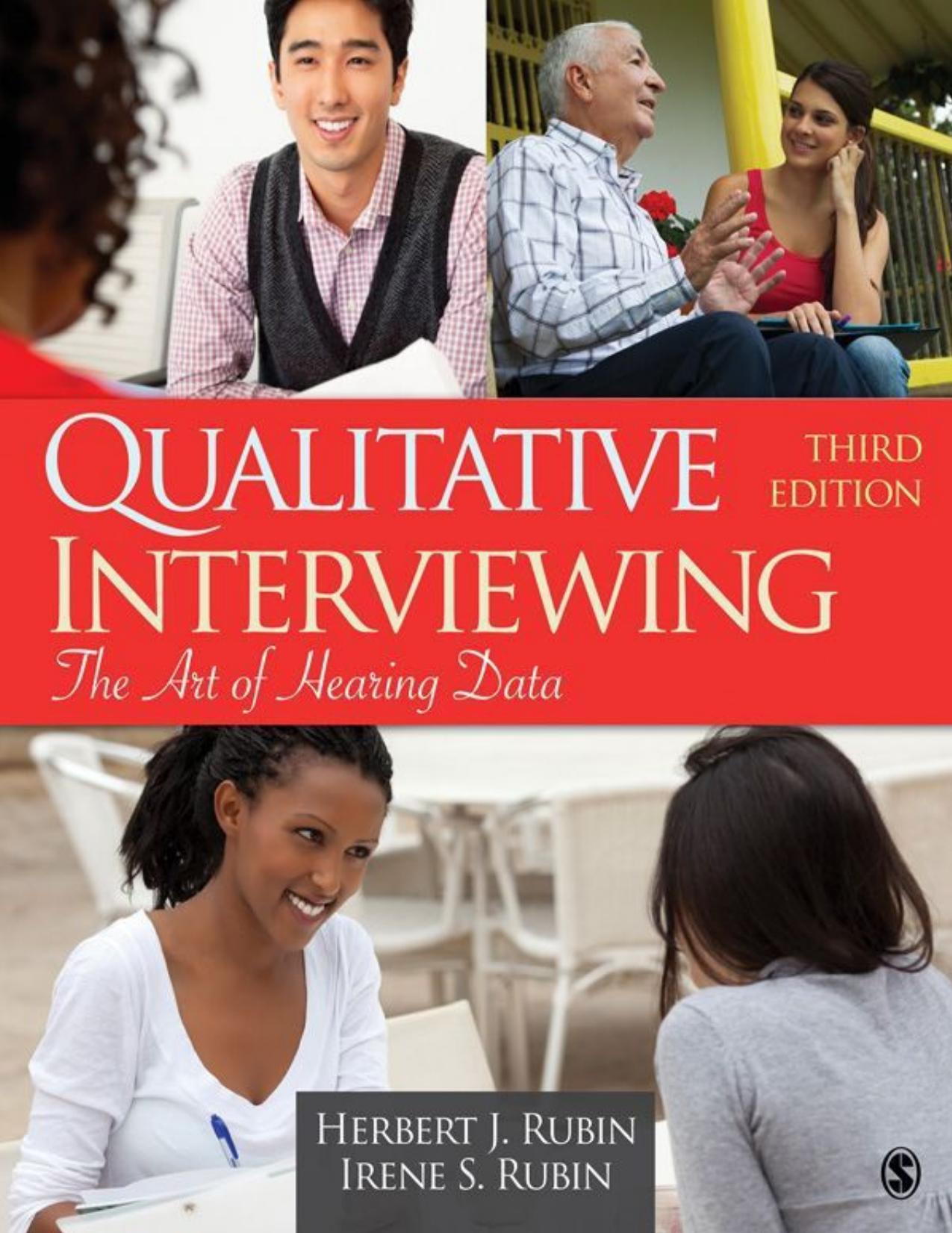Qualitative Interviewing The Art of Hearing Data 3rd Edition by Herbert Rubin, Irene Rubin ISBN 1452285861 9781452285863
$70.00 Original price was: $70.00.$35.00Current price is: $35.00.
Instant download Qualitative Interviewing The Art of Hearing Data 3rd Edition by Herbert J. Rubin Herbert J. Rubin & Irene S. Rubin after payment
Qualitative Interviewing The Art of Hearing Data 3rd Edition by Herbert Rubin, Irene Rubin – Ebook PDF Instant Download/Delivery: 1452285861, 9781452285863
Full download Qualitative Interviewing The Art of Hearing Data 3rd edition after payment

Product details:
ISBN 10: 1452285861
ISBN 13: 9781452285863
Author: Herbert Rubin, Irene Rubin
Using in-depth qualitative interviews, authors Herbert J. Rubin and Irene S. Rubin have researched topics ranging from community redevelopment programs to the politics of budgeting and been energized by the depth, thoroughness, and credibility of what was revealed. They describe in-depth qualitative interviewing from beginning to end, from its underlying philosophy and assumptions to project design, analysis and write up. “This book is exactly what I was looking for in that it covers interviewing and analysis in depth.”—Daphne John, Oberlin College “Students leave this book fully informed of the nuances and complexity of interviewing as well as excited about the promise interview research findings offer.”—Hannah Britton, University of Kansas “The authors′ focus on the reflective process, question development, and procedural steps associated with qualitative research is rich and thorough.”—Tracy M. Lara, Kent State University
Qualitative Interviewing The Art of Hearing Data 3rd Table of contents:
Chapter 1: Listening, Hearing, and Sharing
-
Strengths of In-Depth Interviewing
-
Qualitative Interviewing Compared to Ordinary Conversations
-
Focus and Depth
-
Conversations with Strangers
-
The Authors and the Evolution of the Responsive Interviewing Model
-
The Organization of the Book
Chapter 2: Research Philosophy and Qualitative Interviews
-
Choosing a Philosophy of Research
-
Differences Between Positivist and Naturalist–Constructionist Paradigms
-
An Illustration of the Differences in Practice
-
Variations on the Core Paradigms
-
Positivism Yields to Postpositivism
-
Naturalist and Interpretive Constructionist Perspectives
-
Critical, Feminist, and Postmodern Perspectives
-
Toward the Responsive Interviewing Model
Chapter 3: Qualitative Data-Gathering Methods and Style
-
A Variety of Naturalistic Data-Gathering Techniques
-
Participant Observation
-
Documentary Analysis
-
Conversational and Narrative Analysis
-
In-Depth Qualitative Interviews
-
-
Four Categories of Qualitative Interviewing
-
Focus Groups
-
Internet Interviews
-
Casual Conversations and In-Passing Clarifications
-
-
Semistructured and Unstructured Interviews
-
Topical or Cultural Studies and Style
-
Topical Studies
-
Cultural Studies
-
-
Interviewing Styles
-
Responsive Interviewing
-
The Relationship
-
A Friendly and Supportive Tone
-
Flexible Questions and Design
-
-
Conclusion
Chapter 4: Designing Research for the Responsive Interviewing Model
-
Continuous, Flexible, and Adaptable Design
-
Choosing a Topic
-
Finding a Topic
-
Checking the Topic’s Importance
-
-
Working Out a Focused Research Question
-
Is Qualitative Interviewing the Right Research Tool?
-
Examining Your Research Question for Feasibility
-
-
Choosing Sites, Cases, or Organizations
-
Relevance to Your Research Problem
-
Picking Sites for Feasibility and Access
-
Choosing Sites to Help You Test Tentative Explanations
-
Picking Sites to Allow Generalization of Results
-
-
Conclusion
Chapter 5: Designing for Quality
-
Fresh and Real
-
Balanced and Thorough
-
Accurate and Credible
-
Accuracy
-
Credibility
-
-
Rich and Detailed
-
Conclusion
Chapter 6: Conversational Partnerships
-
Before You Start: Thinking About Yourself
-
Understanding and Accommodating Your Own Personality
-
Choosing a Research Role
-
Crossing Cultural Divides
-
-
Motivating Individuals to Be Interviewed and Making Contact
-
Why Do People Participate?
-
Building Trust
-
Making the Initial Contact and Setting Up Appointments
-
-
Managing Emotions While Interviewing
-
Handling Fatigue and Stress
-
Expressing Your Point of View
-
Managing the End of the Project
-
-
Ethical Responsibilities Toward the Conversational Partner
-
Show Respect
-
Honor Promises
-
Don’t Pressure
-
Do No Harm
-
Institutional Review Boards
-
Expedited Versus Full Review
-
Informed Consent
-
The Questions You Will Ask
-
At-Risk Populations
-
Additional Clues for Dealing with Institutional Review Boards
-
-
Conclusion
Chapter 7: The Responsive Interview as an Extended Conversation
-
Similarities Between Responsive Interviews and Ordinary Conversations
-
Differences Between Responsive Interviews and Ordinary Conversations
-
Answering a Research Question
-
Recording the Interview
-
Key Elements of a Responsive Interview
-
The Stages of a Responsive Interview
-
Introducing Yourself and the Topic
-
Asking Some Easy Questions, Showing Empathy
-
Asking the Tough Questions
-
Toning Down the Emotional Level
-
Closing While Maintaining Contact
-
-
Evaluating Your Interview
-
Conclusion
Chapter 8: Structure of the Responsive Interview
-
Main Questions
-
Follow-Up Questions
-
Probes
-
Balancing Main Questions, Follow-Ups, and Probes
-
Interviewing Patterns
-
Opening the Floodgates
-
Main Branches of a Tree
-
River and Channel
-
Picking Up the Twigs
-
-
Conversational Guides
-
Conclusion
Chapter 9: Designing Main Questions and Probes
-
General Guidance in Working Out Main Questions
-
Use Language Interviewees Understand
-
Allow Interviewees to Answer in Their Own Way
-
Focus on the Experiences and Knowledge of the Interviewees
-
-
Main Questions: What, In What Order, and How
-
What Main Questions to Ask
-
How to Order Main Questions
-
How to Word Main Questions
-
-
Creating and Wording Probes
-
Attention Probes
-
Conversational Management Probes
-
Credibility Probes
-
-
Conclusion
Chapter 10: Preparing Follow-Up Questions
-
Whether to Ask a Follow-Up Question
-
When to Follow Up: Now or Later
-
What to Follow Up
-
Does It Seem Relevant and Important?
-
Is It Incomplete, Vague, or Contradictory?
-
Is It Too General, Too Narrow, or Too Extreme?
-
Do You Need to Explore and Test a Theme?
-
-
Recognizing Places to Follow Up
-
Filling In Missing Pieces
-
Superficial, Too-Broad, or Too-Narrow Answers
-
Pursuing Contradictions and Ambivalence
-
Follow Up on Stories
-
Follow Up on Concepts
-
Follow Up on Themes
-
Follow Up to Explore New and Unanticipated Ideas
-
-
How to Ask Follow-Up Questions
-
Asking How
-
Asking for Comparisons
-
Echo Wording
-
What Is the Alternative?
-
Ask About Components
-
Exceptions
-
Devil’s Advocate
-
Posing Your Puzzle
-
Generalizing
-
Using Hypotheticals
-
What Does It Mean?
-
-
General Guidance for Follow-Up Questions
-
Know the Background
-
Don’t Push Too Hard
-
Ask Concrete Questions
-
-
Conclusion
Chapter 11: Variants of the Responsive Interviewing Model
-
Interviewing in Unusual Places
-
Interviewing Specialized Populations
-
The Very Young
-
The Elderly
-
The Mentally Ill
-
Elites
-
Technical Experts
-
-
Telephone Interviewing
-
Multiparty Interviewing
-
Cross-Cultural Interviewing
-
Problems You May Encounter
-
Some Possible Solutions
-
-
Cross-Language Interviewing
-
Conclusion
Chapter 12: Data Analysis in the Responsive Interviewing Model
-
Transcribe and Summarize
-
Coding
-
Recognizing Concepts, Themes, Examples, Events, and Topical Markers
-
Which Concepts and Themes Should You Code?
-
Marking Codes in the Transcript
-
-
Coding Using the Grounded Theory Model
-
Sort and Summarize, Sort and Compare
-
Weigh and Integrate
-
Generate Your Own Theory
-
Theory Building in the Grounded Theory Model
-
Generalize Your Findings
-
-
Conclusion
Chapter 13: Sharing the Results
-
Outlets for Qualitative Research Reports
-
Managing Style and Tone
-
Style
-
Controlling Tone
-
-
Starting to Write
-
Drafting the Manuscript
-
Revamping and Revising
-
Judging the Quality of Writing
-
Engaging and Readable
-
Rich and Nuanced
-
Thorough and Credible
-
-
Getting Feedback
-
Getting Published
-
Journals
-
Books
-
-
Conclusion
Chapter 14: Personal Reflections on Responsive Interviewing
-
As Researchers and Teachers
-
As Social and Political Activists
-
As Individuals
Appendix: Computers and Qualitative Data Analysis
References
Author Index
Subject Index
People also search Qualitative Interviewing The Art of Hearing Data 3rd:
qualitative interview techniques
how many questions for a qualitative interview
qualitative interviewing the art of hearing data pdf
qualitative interviewing the art of hearing data
can structured interviews be qualitative
Tags: Herbert Rubin, Irene Rubin, Qualitative Interviewing, Hearing Data


